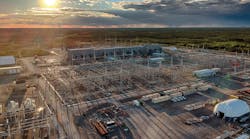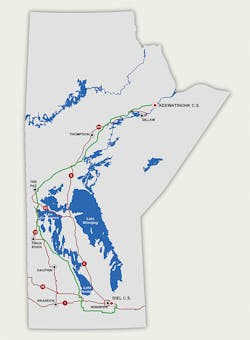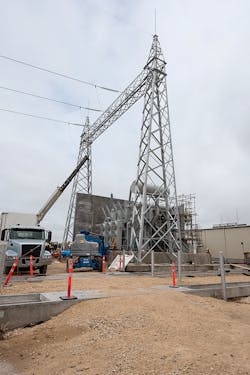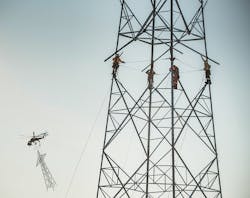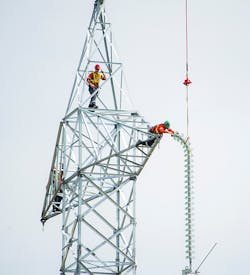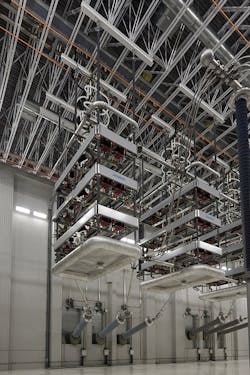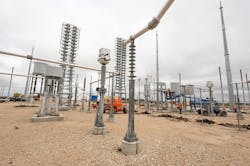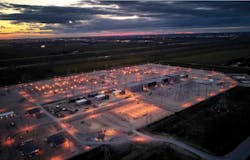A provincial Crown Corp., Manitoba Hydro serves almost 600,000 electric customers in Manitoba, Canada, and about 300,000 natural gas customers in southern Manitoba. As one of the largest vertically integrated energy utilities in Canada, Manitoba Hydro not only leverages the massive scale of its hydroelectric plants to keep the lights on throughout the province, but it also makes clean, near-zero emissions energy available for export to utilities in the neighbouring province of Saskatchewan and the northern U.S.
Manitoba Hydro’s extra-provincial sales of renewable electrical energy helps its export customers to reduce their own greenhouse gas emissions, by reducing the use of coal, and enabling them to incorporate less reliable renewables, such as wind and solar. With so many people counting on it, the utility recently invested in a new high-voltage direct-current (HVDC) transmission line to maintain the security of supply for its HVDC system.
Existing HVDC Lines
Some 70% of power produced by Manitoba Hydro is generated in northern Manitoba by hydroelectric generating stations on the Nelson River. Nearly all this hydroelectric power has historically been delivered to customers in southern Manitoba through the Bipole I and Bipole II HVDC transmission lines constructed in the 1970s. These two transmission lines were erected alongside each other for most of their route through the middle of the province, and both circuits are terminated at the Dorsey converter station, located northwest of the provincial capital city, Winnipeg.
Because of the routing of the Bipole I and Bipole II circuits as well as the common terminal point, major weather events such as tornadoes or ice storms, present a significant risk to the operation of the HVDC system and reliability of the power supply to Manitoba Hydro customers. The susceptibility of the HVDC system was exposed by Mother Nature when a severe wind event in 1996 took out 19 towers on both circuits for four days. For the first time in history, Manitobans were requested to reduce their nonessential power consumption while utility field crews worked to re-erect and replace damaged towers.
More recently, in 2011, the Bipole I and Bipole II transmission lines were subject to severe flooding in the remote north because of high river conditions. When winter arrived and the water froze, approximately 50 towers were lifted off their foundations. As a result, Manitoba Hydro was obliged to start up its two thermal power plants to cover the potential loss of transmission capacity from its HVDC system. To address these risks and maintain the security of supply for their HVDC system, Manitoba Hydro decided to invest in the construction of Bipole III, a 500-kV HVDC transmission line.
Bipole III HVDC
To minimize the risk of weather-related circuit outages in the future, the Bipole III HVDC transmission line was erected on a different route, through the western part of Manitoba. The project also included two new converter stations. The first one was the Keewatinohk converter station, located on Fox Lake traditional, territory, approximately 80 km (49.7 miles) northwest of the town of Gillam in northern Manitoba. The second was the Riel converter station, just east of Winnipeg, that also includes additional 230-kV AC interconnections to integrate the new HVDC system.
The new Bipole lll HVDC transmission line has a total of 3078 towers that, together with the converter stations, provide 2000 MW of additional capacity and a completely independent and physically separate HVDC system. This will significantly reduce the impact severe weather events may have on the HVDC system in the future.
Converter Stations
The design of the new Bipole III converter stations leveraged more than 40 years of Manitoba Hydro’s operational experience on the Bipole I and Bipole II systems. The utility elected to continue to use conventional thyristor technology for Bipole III, based on the proven reliability of this technology in the Bipole I and Bipole II converter stations. Similarly, the Bipole III converter stations are designed with two converter groups per pole to reduce the impact single converter outages have on transmission capacity. The design and construction of the converter equipment — including the direct-current (DC) switchyard, alternating-current (AC) harmonic filters and converter building — was completed by the consortium of Siemens Canada Ltd. and Mortenson Construction.
Manitoba presents a unique climatic challenge, with summertime temperatures nearing 40°C (100°F) and winter low temperatures of -50°C (-58°F). All equipment used within the converter stations had to meet these challenging temperature extremes, requiring, in some cases, for equipment designs to be modified or the equipment to be installed safely indoors away from the elements.
Connecting the Keewatinohk converter station into Manitoba Hydro’s existing northern 230-kV AC network was accomplished through the design and construction of a new AC switchyard by SNC-Lavalin Inc. This switchyard includes fully redundant IEC 61850 control and protection systems as well as redundant 12-kV and 600-V auxiliary power systems for reliable converter station operation.
At the Riel converter station, four large 250-MVAR synchronous condensers — manufactured and installed by the consortium of Voith Hydro Inc. and Stuart Olson Industrial Constructors Inc. — were required to provide reactive power for the HVDC conversion process and stabilize the southern power system. Each synchronous condenser is cooled with hydrogen gas for optimal performance. As a result, several safety systems are incorporated into the design to manage the hydrogen gas safely when in operation.
Construction Challenges
The design and construction of the Keewatinohk converter station built in northern Manitoba presented additional challenges for the project. Located alongside the Nelson River in an area of discontinuous permafrost, building and equipment foundations required specialized designs to provide the required capacity and minimize the cost of construction in this remote northern location. Driven steel and helical piles were selected for most of the foundations within the converter station.
Because there was no local infrastructure to accommodate the workforce required to construct the Keewatinohk converter station, a temporary workers lodge was constructed to accommodate the 600-person workforce. Manitoba Hydro worked with Fox Lake Cree Nation, on whose traditional territory the converter station was constructed, to design and build a home away from home for the construction workers that incorporated cultural elements to provide a unique and welcoming environment for the residents.
Delivering the large HVDC converter transformers from Germany and synchronous condensers from Quebec, Canada, to the Bipole III converter stations required meticulous planning and coordination. A combination of dedicated rail deliveries, heavy transport trucks and specialized self-propelled multi wheeled vehicles ensured safe delivery and placement of the critical equipment, each weighing in excess of 250,000 kg (250 tonnes), through the 2016 and 2017 construction program.
The converter stations were a massive and complex endeavour involving multiple contractors from around the world and more than 10 million man-hours to complete. During the peak construction period in 2016, some 1200 people were engaged in the construction of the two converter stations.
Line Construction
The route selected for the 500-kV Bipole III transmission line, which interconnects the two new converter stations, traverses nearly every soil condition found in Manitoba, including muskeg bogs, boreal forest and prairie farmlands. Many years prior to construction of the Bipole III transmission line, Manitoba Hydro was engaged in the environmental licensing process for the project. Acquiring land and routing for this 1388-km (860-mile) circuit required meticulous attention to detail. It involved working with the agricultural producers in southern Manitoba to protect them from potential biosecurity risks during construction of the transmission tower foundations and structures. As a result, stringent protocols designed to prevent the introduction of invasive species and pathogens were developed and put into practice.
Because of the variable soil conditions and terrain, the transmission line comprises a variety of tower foundations and tower designs, including self-supporting steel lattice towers in the south and guyed steel lattice structures in the north. In the northern locations, construction of the transmission line took place only during the winter months, when the ground was sufficiently frozen for heavy equipment to access the area.
Some of the remote Manitoba terrain along the transmission line route is notoriously swampy and access to tower positions was found to be challenging. To overcome this, much of the tower erection work construction relied on the use of large helicopters to ferry preassembled tower structures to the site, where they were erected to remain in service for decades.
The Bipole III transmission line uses anti-cascading tower designs to minimize the length of the line that may be damaged in the event of an extreme wind or ice storm. Each HVDC pole on the transmission line comprises a triple-bundle 806-A4-61 all-aluminum alloy conductor (AAAC) supported by 28 220-kN insulators. Operational experience from the Bipole I and Bipole II transmission lines was used to optimize the conductor bundle geometry and insulator lengths to further improve insulation performance. Shielding the transmission line is a 48-fiber optical ground wire, which provides a communication path between the converter stations. Four optical repeater facilities were constructed along the length of the transmission line to ensure enough signal strength.
Community Involvement
This project gave Manitoba Hydro the opportunity to engage and work closely with the indigenous and Métis people of the province on training and employment initiatives. About 80% of the workers hired for the Bipole III project were Manitoban, with almost half from the indigenous people. This was not restricted to boots-on-the-ground employment; every effort was made to promote the participation of indigenous businesses in the procurement of goods and services for the project to support the growth of a robust, competitive indigenous business sector in Manitoba.
Results
Manitoba Hydro commissioned the Bipole III project in July 2018, thereby completing its third HVDC transmission line, delivering renewable hydroelectric power produced in northern Manitoba to customers in southern Manitoba. It took five years to construct, many more in planning and, at its height, was one of the largest construction projects in North America.
This new 1388-km (860-mile), 500-kV HVDC transmission line now does what it always was intended to do: increases the reliability of the electric grid for the Canadian province of Manitoba.
For more information:
Manitoba Hydro | www.hydro.mb.ca
Mortenson Construction | www.mortenson.com
Siemens Canada | www.siemens.com
SNC-Lavalin | www.snclavalin.com
Stuart Olson Industrial Constructors | www.stuartolson.com
Voith Hydro | www.voith.com
